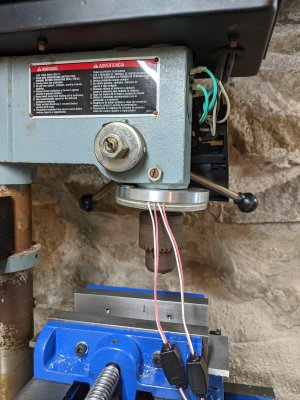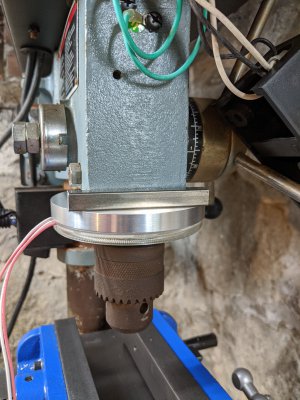-
Welcome back Guest! Did you know you can mentor other members here at H-M? If not, please check out our Relaunch of Hobby Machinist Mentoring Program!
You are using an out of date browser. It may not display this or other websites correctly.
You should upgrade or use an alternative browser.
You should upgrade or use an alternative browser.
LED spindle light
- Thread starter WobblyHand
- Start date
- Joined
- Sep 28, 2013
- Messages
- 4,306
If you can, I'd avoid the power supply pictured like the plague. I bought 3 some years ago and every single one of them blew. They got very hot, but even with ventilation holes drilled in the case they still blew up. I think that they're just undersized or inefficient for the power (1.5A) they're supposed to provide.
You can get sealed power supplies and they'll usually provide screw holes to attach them to a heat sink.
some low power ones

2 x LED driver transformer power transformer with waterproof connection cab G1E1 for sale online | eBay
Find many great new & used options and get the best deals for 2 x LED driver transformer power transformer with waterproof connection cab G1E1 at the best online prices at eBay! Free shipping for many products!
www.ebay.com
higher power one (got the 10W version)

Power Supply IP65 Waterproof Adapter DC 12V/24V LED Driver Lighting Transformer | eBay
Find many great new & used options and get the best deals for Power Supply IP65 Waterproof Adapter DC 12V/24V LED Driver Lighting Transformer at the best online prices at eBay! Free shipping for many products!
www.ebay.com
Used both of those on some garage LED lights, probably had 40-50h or more (hard to keep track) since I built them. Also used a bunch of 12-15V 900mA drivers, but I'd have to do some digging to find a listing.
Not sure what the current draw of those LED rings is, probably less than 10W I'd guess. If you need a power supply >10W I'd suggest going with a larger power supply than you showed. I think those things are just underbuilt for their output.
- Joined
- Dec 18, 2019
- Messages
- 6,447
Thanks for your thumbs down on that power supply. I don't want to go through the effort of mounting stuff, only to have it fail in short order. What was the load on the power supply that blew up? Together, the two rings consume 0.6A, (7.2W) which is only 40% of rated capacity. (I usually don't load power supplies over 50% as a general practice.)If you can, I'd avoid the power supply pictured like the plague. I bought 3 some years ago and every single one of them blew. They got very hot, but even with ventilation holes drilled in the case they still blew up. I think that they're just undersized or inefficient for the power (1.5A) they're supposed to provide.
You can get sealed power supplies and they'll usually provide screw holes to attach them to a heat sink.
some low power ones

2 x LED driver transformer power transformer with waterproof connection cab G1E1 for sale online | eBay
Find many great new & used options and get the best deals for 2 x LED driver transformer power transformer with waterproof connection cab G1E1 at the best online prices at eBay! Free shipping for many products!www.ebay.com
higher power one (got the 10W version)

Power Supply IP65 Waterproof Adapter DC 12V/24V LED Driver Lighting Transformer | eBay
Find many great new & used options and get the best deals for Power Supply IP65 Waterproof Adapter DC 12V/24V LED Driver Lighting Transformer at the best online prices at eBay! Free shipping for many products!www.ebay.com
Used both of those on some garage LED lights, probably had 40-50h or more (hard to keep track) since I built them. Also used a bunch of 12-15V 900mA drivers, but I'd have to do some digging to find a listing.
Not sure what the current draw of those LED rings is, probably less than 10W I'd guess. If you need a power supply >10W I'd suggest going with a larger power supply than you showed. I think those things are just underbuilt for their output.
I do have a 3A supply (36W), but it was a little large for an internal mount. If I mount it on the outside of the drill press belt cover, on the top, I'm sure the 3A one would last forever. I've used 3 of the 36W supplies in the past - no failures over more than 2 years. I'm using them for homemade LED light strips, which I installed under the kitchen cabinets. They have worked quite well. I also have one powering 2 3ft LED strips over my desk.
Think I'll try to adapt the larger supply.
- Joined
- Dec 18, 2019
- Messages
- 6,447
Yes. PM coming.I see my name has been invoked in the quest for a mill
Feel free to ping me if you have questions about my quest and where I ended up.
- Joined
- Sep 28, 2013
- Messages
- 4,306
First two were a Cree MC-E Easy white, which shouldn't have been drawing more than 1A but was probably drawing way over that (3 out of 4 of the LED dies blew out eventually), third was on the replacement Cree CXA which should have been running at the supply's rated 1.5A. Both LEDs were on a large CPU heatsink out of a Mac work station, so overheating of the LED shouldn't have been an issue. The supplies were screwed to the heatsink too, but there's really no decent thermal path between the supply inside and the heatsink.
I'd definitely go with the 3A supply you have, especially if you've had a lot of success with them. Those LED strips/ rings have current limiting resistors wired in series with each set of 3 LEDs, so you won't blow them up with a higher rated supply.
I'd definitely go with the 3A supply you have, especially if you've had a lot of success with them. Those LED strips/ rings have current limiting resistors wired in series with each set of 3 LEDs, so you won't blow them up with a higher rated supply.
The circuit probably regulates the current to the LEDs. Back go the covers. Well, so much for neatening up the unsightly bump!
Does that circuit need to be that close to the LEDs? You might be able to move it next to the power supply to clean things up.
- Joined
- Dec 18, 2019
- Messages
- 6,447
Don't know how close it needs to be. Moving it would be easy enough. Definitely would clean things up.
- Joined
- Dec 18, 2019
- Messages
- 6,447
Although the magnets hold up the LEDs without problem, the ring isn't flat relative to the casting. Part of that is droop due to gravity, and the most important factor is the fact that the casting itself isn't flat at all. I really don't want to hand file the casting flat in an upside down position. I don't have any idea of how much meat there is, and don't want to chance it. If it was flat, then the magnets would have more than enough strength to hold the assembly. I'm going to plan B.
Plan B requires attachment of a small piece of key stock to the front of the casting. I should be able to drill 2 holes in the casting and tap them. A couple of 10-24 screws can fasten the key stock to the casting. The LED ring will be modified to add a couple more magnets to the front. This way the ring will be supported in both the front and back. The front surface will be flat, so the magnets will stick with great force. The key stock will mostly be hidden by the switch cover which is in that area. Of course the casting isn't flat in the front either. To compensate for that I will file or grind out the key stock in the center so it will mount a little flatter on the casting. If I get lazy, or tired of filing, I'll stack washers to fit! Now that I think about it, it would be very nice if I could find a supply small enough to fit under the cover plate area, that way all the wiring and mounting could be done in a tidy area.

Ring held up, but not level. You can see the tilt.

Add keystock, or equivalent here. Gives magnets something flat to stick to, and would support the ring on two sides. Need a piece of steel that is about 1/2", the 3/8" doesn't quite let me get the screw holes in the right place. (Too close to the edge of the casting.)
Plan B requires attachment of a small piece of key stock to the front of the casting. I should be able to drill 2 holes in the casting and tap them. A couple of 10-24 screws can fasten the key stock to the casting. The LED ring will be modified to add a couple more magnets to the front. This way the ring will be supported in both the front and back. The front surface will be flat, so the magnets will stick with great force. The key stock will mostly be hidden by the switch cover which is in that area. Of course the casting isn't flat in the front either. To compensate for that I will file or grind out the key stock in the center so it will mount a little flatter on the casting. If I get lazy, or tired of filing, I'll stack washers to fit! Now that I think about it, it would be very nice if I could find a supply small enough to fit under the cover plate area, that way all the wiring and mounting could be done in a tidy area.

Ring held up, but not level. You can see the tilt.

Add keystock, or equivalent here. Gives magnets something flat to stick to, and would support the ring on two sides. Need a piece of steel that is about 1/2", the 3/8" doesn't quite let me get the screw holes in the right place. (Too close to the edge of the casting.)
- Joined
- Mar 21, 2018
- Messages
- 1,597
That little nodule is a boost converter. The LED supply only puts out 12V. If all the LEDs are in series (which keeps the current low), then the voltage required would be 3 x N, where N is the number of LEDs. If there are 33 LEDs, then the voltage would be close to 100V, with a current around 0.100 mA (depending of the type of LED). The boost converter can be anywhere after the supply.
- Joined
- Dec 18, 2019
- Messages
- 6,447
Thanks. I think I'll tuck them inside the drill press switch area to keep them out of harms way.That little nodule is a boost converter. The LED supply only puts out 12V. If all the LEDs are in series (which keeps the current low), then the voltage required would be 3 x N, where N is the number of LEDs. If there are 33 LEDs, then the voltage would be close to 100V, with a current around 0.100 mA (depending of the type of LED). The boost converter can be anywhere after the supply.

